Ṭukṛā – टुकड़ा
Quick Definition: A cadential composition usually beginning with an opening section of phrases, followed by a tihai. Tukras are often fixed, but improvised tukras and tukra variations are common. Performed in tabla solo and accompaniment.
Literal Meaning: piece; fragment; bit
Tukra Examples in Tintal:
Tukra Example 1
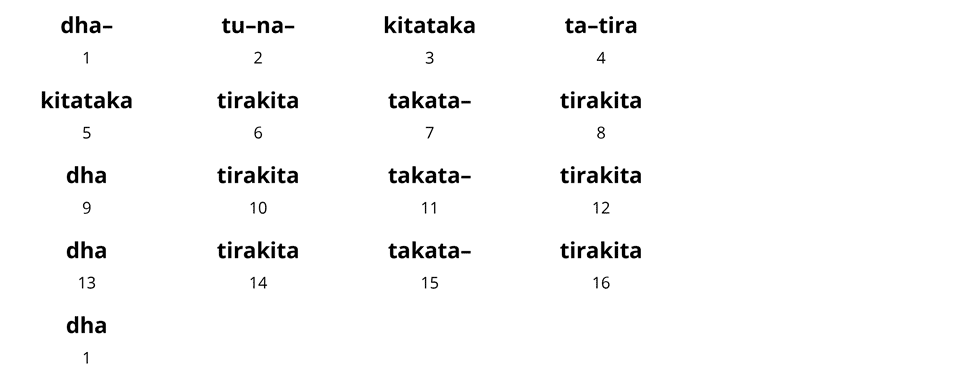
Performed Once:
(from Benares Tukra 2)
Tukra Example 2
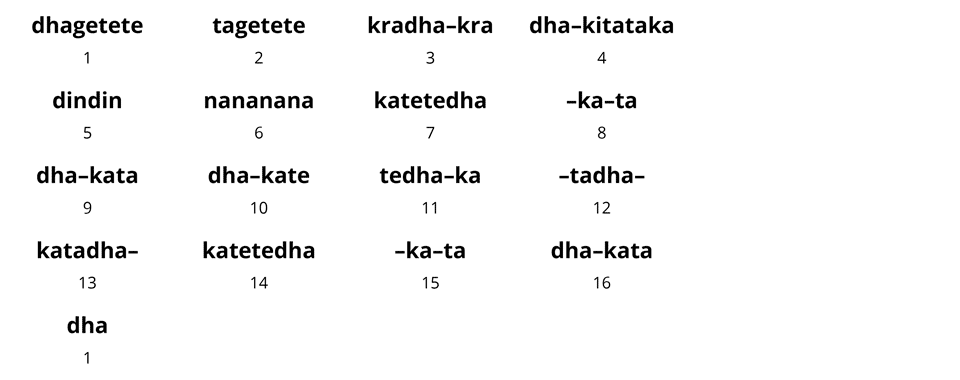
Performed Once:
(from Benares Tukra 5)
Introduction to Tukra
In contrast to cyclic forms like the kayda, the tukra is a non-symmetrical, cadential form which builds up to the sam (the 1 of the tal). As the kayda is the primary representative of theme-and-variation/cyclic forms, so the tukra is the primary example of fixed/cadential forms.
The tukra can be one of the most unique and exciting forms in classical tabla . With its irregular structures and phrases, we hear the language of the tabla in one of its most free and unpredictable environments. Rebecca Stewart may have been right when she called the tukra the “pièce de résistance” (“the most remarkable example”) of the tabla repertoire (p. 257).
But because the tukra is so unpredictable, it may not be easy for new listeners to follow. However, with some understanding of common tukra structures and phrases, you should be able to start appreciating this exceptional form. And like the kayda, if you learn something about tukras, it will help you to understand other similar forms, such as the paran, chakradar, uthan, and mukhra-mohra.
Tukra Background
It is generally believed that the tukra form developed in the purab gharanas, first in Lucknow, and then in Farrukhabad, and Benares. And until today, the tukra form is strongest in these gharanas.
Most writers and musicians also agree that the tukra evolved from the pakhawaj paran. In fact, some tukras are very similar to parans. And some of the most common tukras use phrases which are clearly from the pakhawaj tradition.
With the paran influence, the tukra also inherited many phrases and patterns from kathak dance. The gharanas of Lucknow and Benares are most noted for their kathak influence.
Tukra Characteristics
Here is a summary of tukra characteristics, which we will look at in more detail below:
- The tukra is cadential in nature, and almost always builds up to the sam. It is not a symmetrical form like the kayda, rela or laggi.
- The most common tukra structure includes an opening section followed by a tihai.
- Most tukras are short. In tintal (16-beat cycle), 1 to 2 avartans (cycles of the tal) is common, though they may be longer depending on the performance tempo.
- The bols (strokes and phrases) used in tukras are usually khula baj (“open style”) with many strokes from pakhawaj. However, non-pakhawaj bols are also common.
Tukras are often classified as fixed compositions. And this is partly true; there are many traditional tukras in every gharana. But, as we will see below, tukras are not always fixed. We also see:
- Different versions of traditional tukras, even within the same gharana
- Variations of the same tukra performed together
- Improvised tukras
- Tukras adapted to fit in other tals
Tukra Structures
The most common tukra structure begins with an opening section (mukhra) followed by a tihai (a phrase repeated 3 times):

But there is a lot of variety in how these two elements are combined. Sometimes the mukhra is long and the tihai is short. Other times the mukhra is short and the tihai is long. There are tukras with only a tihai and no opening section. And there are also tukras with no tihai, though they are rare.
Below we will look at a few examples of some common tukra structures. But first I will say a few words about the opening section.
The Tukra’s Opening Section: Mukhra
Some players use the term mukhra for the opening of a tukra . In the first example tukra from above, the mukhra is the first 5 matras:
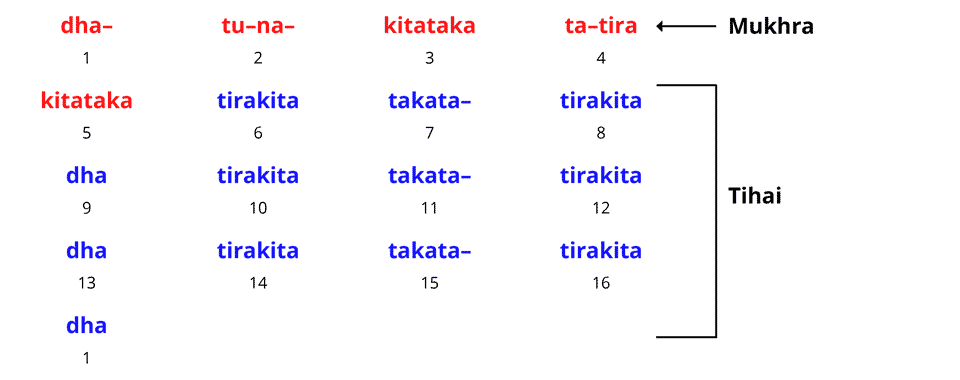
This kind of mukhra is not the same as the more common mukhra, which is a sequence of bols that builds up to the sam (see the Mukhra-Mohra section). But it makes sense, since one of the meanings of mukhra is “front” or “face”.
However, not everyone has a name for this part of a tukra. In tabla literature, it is more often called an “introduction” or “opening”.
The Basic Tukra Structure: Mukhra plus Tihai
The basic tukra structure has a mukhra, followed by a tihai which ends on sam (the 1 of the tal). Most traditional tukras will also start on sam.
Here again is the example tukra from above. This tukra lasts for one cycle of tintal (16 matras) and ends on sam of the second cycle:

So whether a tukra lasts for one, two, or four cycles, we will always add one matra (beat) to finish on the sam of the next cycle.
The tukra above lasts for 17 matras (16 + 1). A two-cycle tukra in tintal will last for 33 matras (32 + 1). Etcetera.
Tukra with Three Tihais
A second common tukra structure has a mukhra followed by three tihais (the same tihai played three times in a row). The example below lasts for two cycles of tintal: 33 matras (32 + 1) divided into 9.5 matras of mukhra, and a 23.5-matra tihai.
The tihai itself contains a small tihai: [ta– tirakita (dhati dha) (dhati dha) (dhati dha)] x3:
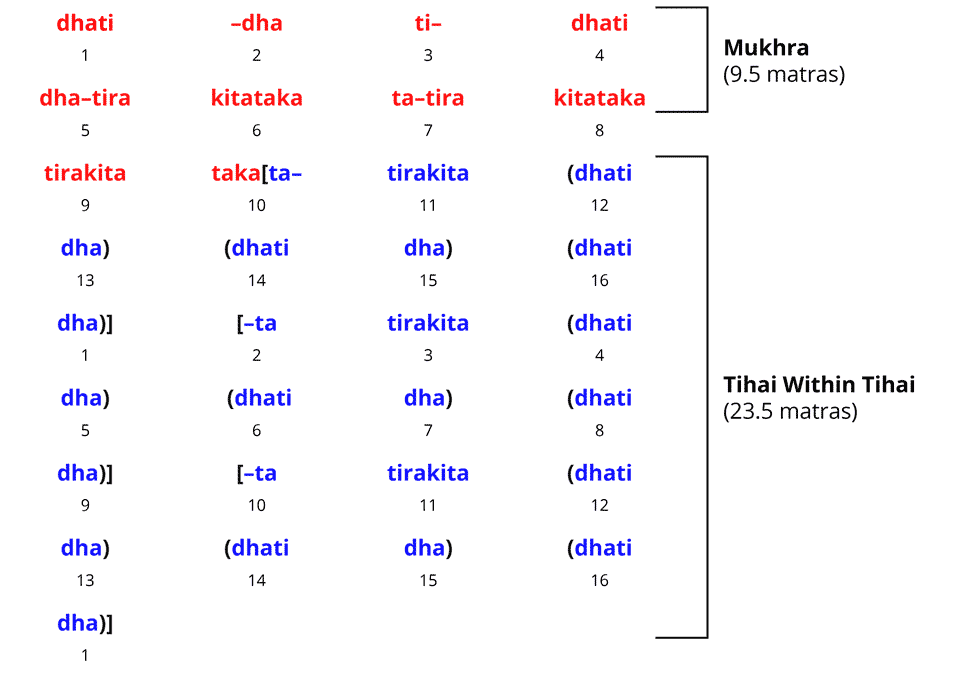
Performed Twice with Tintal Theka:
(from Benares Tukra 6)
Tukra with No Tihai
A less common type of tukra has no tihai. Of these, there are two types. One is essentially the same as a long mukhra where there is no tihai at all. The other has what we can call a “psuedo tihai”.
Tukra with Long Mukhra but No Tihai
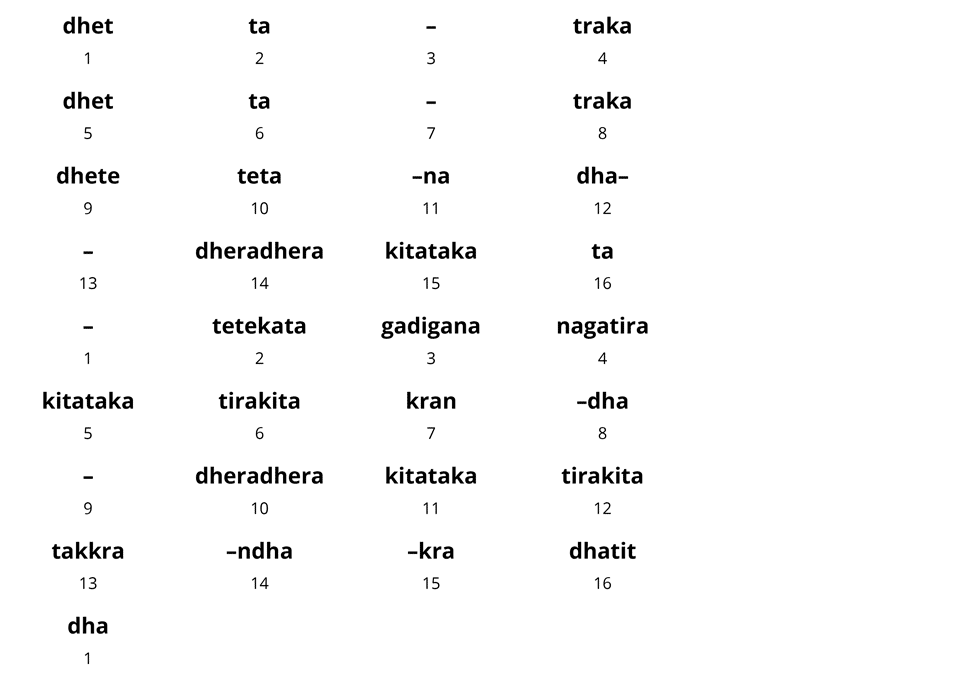
On the surface, this tukra looks similar to the more common type of mukhra without a tihai. But there are a few differences.
First, it is longer than a typical mukhra. Also, the movement is different than most mukhras. There are unusual gaps and off-beat phrases which are more typical of tukras than mukhras. And mukhras usually have a clearer sense of flow and buildup to the sam.
Tukra with a Quasi Tihai
Another kind of tukra has what we can call a quasi tihai (similar to, but slightly different, than the incomplete tihai that we hear in the peshkar).
The quasi tihai is a phrase which repeats three times like a tihai, but there is no dha at the end of each phrase until the last repetition (each repetition of a tihai normally ends with dha). And so it feels like a tihai, but technically it is not.
In the tukra below, the phrase dhatrakadhe tetekata gadidana repeats three times but there is no dha at the end until the last repetition:
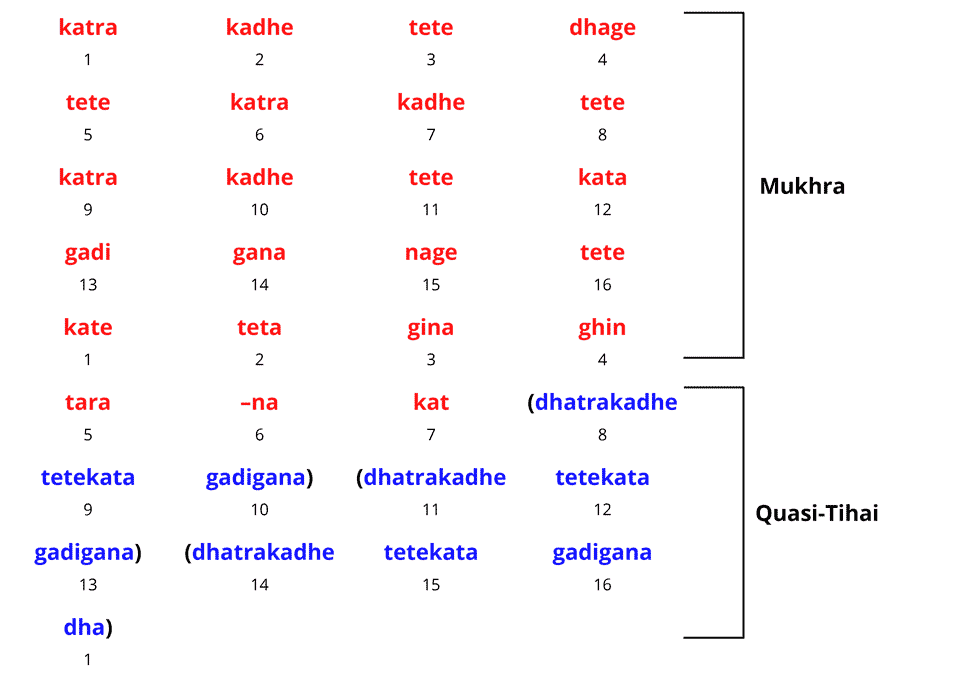
Tukra Bols (phrases)
As you can see from the examples so far, tukras use a wide variety of different bols. However, most traditional tukras use bols which are khula baj (“open style”), including many pakhawaj bols. Numerous authors have also noted this. However tukras are not limited to pakhawaj-type bols.
Below is a short list of some of the more common bols used in traditional Benares tukras. Many of these bols are also common in tukras from other gharanas. Keep in mind this is a limited sample:
- tirakiṭadhet – तिरकिटधेत्
- dheradherakiṭataka – धेरधेरकिटतक
- takiṭadha – तकिटधा
- dhā-tirakiṭataka – धाऽतिरकिटतक
- ghe-tirakiṭataka – घेऽतिरकिटतक
- dhāgeteṭe – धागेतेटे
- tāgeteṭe – तागेतेटे
- nāgeteṭe – नागेतेटे
- teṭekata – तेटेकत
- gadigana – गदिगन
- kiṭataka – किटतक
- tirakiṭa – तिरकिट
- takkṛān – तक्क्ड़ां
- katadhā – कतधा
- kradhā – क्रधा
- taṛā–na – तड़ाऽन
- dhā–nadhā – धाऽनधा
See the Compositions section for more tukra examples.
Tukra Variations
Teachers will sometimes teach variations of the same tukra, or a sequence of similar tukras made from the same bols. And creating a variety of tukra or tihai forms from the same bols is a common practice in tabla solo. Players will also adapt tukras from one tal to fit in another tal.
Such variations are made by making changes to the mukhra, to the tihai, or to both. Changes can include rearranging bols, repeating bols, or adding pauses.
Generally, no new bols are added to create the variations. And the tukra variation may or may not be the same length as the original.
Below again is the the second example tukra from the beginning of this section (from Benares Tukra 5). It has 6 matras of mukhra and 11 matras of tihai:

Performed Once:
And here is a variation of this tukra. It has 9 matras of mukhra and 8 matras of tihai:
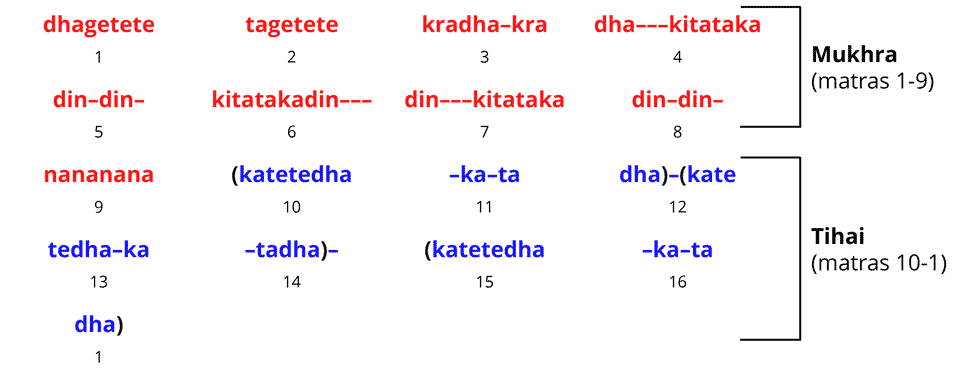
To make this variation we lengthened the mukhra by 3 matras. To do this, we repeated the phrase kitataka din-din- three times. But now we have fewer matras for the tihai, so we must shorten the original tihai phrase.
The original tihai phrase was katetedha -ka-ta dha-kata dha. From this, we cut the last kata dha, which gives us katetedha -ka-ta dha played 3 times with just a quarter-matra pause..
Here is another variation of this tukra:
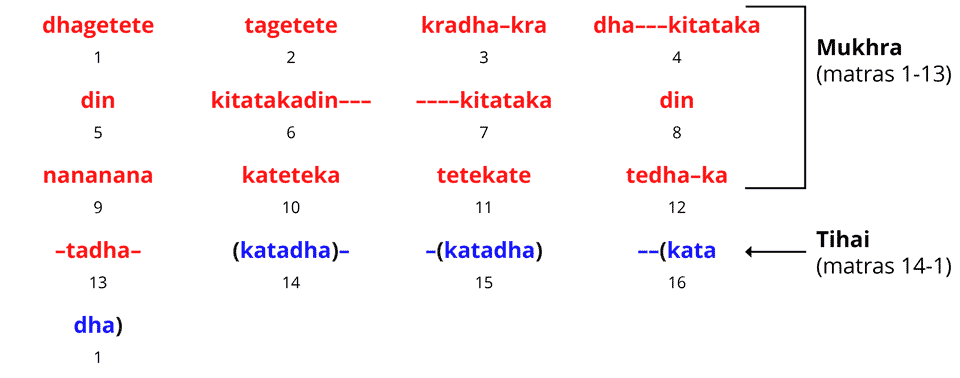
This variation has 13 matras of mukhra and only 4 matras of tihai. The first 9 matras of the mukhra is almost identical to the last variation (it repeats kitataka din three times). But then there are four more matras of mukhra made from bols from the original tihai (kateteka tetekate tedha-ka -tadha-). The tihai is now very short (katadha x3).
Listening to Tukras
For new listeners, it may take some time before you start to understand and appreciate tukras. Naturally, it will be easiest if you start with simple tukras, such as Benares Tukras 1-3. The Overview sections for the tukras on this webiste will (eventually) have guides for each composition.
Whenever possbile, try to identify the two major parts of the tukra: the mukhra and the tihai. Note exactly where the tihai begins. If either the mukhra or tihai is complex, try to understand the different phrases that create each one.
Beyond that, you just have to listen—and speak—as much as possible, preferably while keeping time.
Like most classical tabla compositions, the key to understanding tukras is to recognize the individual phrases. And many of the phrases in tukras can be heard over and over again, not only in other tukras, but in different kinds of compositions as well.
References
Kippen, James. The Tabla of Lucknow – A Cultural Analysis of a Musical Tradition. Cambridge: Cambridge University Press, 1988.
Misra, Chhote Lal. Tal Prabandh. New Delhi: Kanishka Publishers, 2006. (Hindi)
—. Tabla Granth. New Delhi: Kanishka Publishers, 2006. (Hindi)
Naimpalli, Sadanand. Tabla for Advanced Students. Mumbai: Popular Prakashan Pvt. Ltd., 2009.
Saxena, Sudhir Kumar. The Art of Tabla Rhythm. New Delhi: D.K. Printworld (P) Ltd., 2006.
Stewart, Rebecca Marie. The Tabla in Perspective. Unpublished Ph.D. thesis, University of California, Los Angeles, 1974.